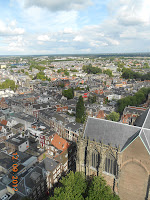Here I've tried to condense my love of Amsterdam into coherent paragraphs which is no mean feat! My Dad turned 60 this week (Happy Birthday Dad! I love you lots!) and being in the company of my amazing twin sister and friend from England was enough to get me thinking about where it is that I feel most at home. After these past few days I think a part of me will always say Amsterdam.
Art.
Unfortunately the Rijksmusuem was closed but its neighbour, harbouring works from one of the not so traditional Dutch masters, the Van Gogh Museum, was open and I needed no invitation. His downward spiralling rollercoaster life reflected in his move from the traditional Dutch earthy palette with realistic subject matter (epitomised in
The Potato Eaters) to his renowned bold, expressive brushstrokes and bright colours (particularly in
Wheatfield with Crows) has always excited me. Always on the periphery in life I love that in death his works takes central stage. Indeed art itself is intrinsic to the city. From the graffiti and expression of the coffee shops*, the merchandise of the markets, the posters on street posts, the tenuous reflection of tightly packed houses in its canals to the National Monument that casts its shadows over the street performers in Dam Square. Art is everywhere.
Culture.
Half the beauty of Amsterdam’s architecture is rooted in it: churches, both old and new, the Koninklijk Paleis. The same can be said for the Bloemenmarket (Flower Market) and Noordermarkt (a flea market) which adorn the beautiful canals that circle the city since they reflect the Dutch’s rich trading past and present. On sale: traditional Dutch wooden clogs, tulips and bulbs, all manner of cheeses and Dutch favourites;
stroopwaffels (a ‘syrup-waffle’),
poffertjes (mini pancakes), drop (liquorice) and dare I say, cannabis. The home of Heineken, the Heineken Experience was a light-hearted must see; taking you through the process of its creation and astounding success.
History.
A visit to Amsterdam would not be complete without one to the Anne Frank House. Her remarkably detailed diary entries come alive when you truly stand where she stood, so much so I felt a knot in my heart, a kind of mixture of fear and anxiety as I climbed the steep stairs to their Annex. I can’t possibly begin to imagine how she must have felt, day and night. The house itself, at her father Otto’s request, is vacant of furniture so as you walk around the hollow wooden rooms reading the quotations from her diary on the walls or listening to interviews with friends or family of Anne you really begin to sense just a snippet of the longing she had to be free, be outside enjoying the nature that Amsterdam has in abundance. One day I will read the original version of her diary, the Dutch version.
Nature.
Amsterdam has more to offer then one might think to a nature-lover like me. The urban location for its small Hortus Botanicus, holding an enormous diversity of plants, actually added to its charm. The highlight for me was the Three-Climate Greenhouse, at the slide of a door and within the space of a couple of metres you walked through the sub-tropical, the desert and the tropical. For Amsterdam’s home grown nature you need not look further than its parks, the Vondelpark is one of note. The laughter, music and picnic scents of the Sunday afternoons in the Vondelpark ensure pure relaxation. Many happy hours were spent there with my twin and friend who had come to visit me. Strangely Amsterdam’s laid back atmosphere is evident even on the most metropolitan parts of its canals, where boats struggle to pass by each other or fit beneath the low lying bridges. We found all this out when taking out a Canal Bike (a pedalo) for an hour or so!
*Coffee Shops, of which there are infinite amounts, are those which sell cannabis in Amsterdam. If a place is called a cafe then that's where they will actually offer coffee!















